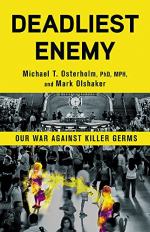
|
| Name: _________________________ | Period: ___________________ |
This test consists of 15 multiple choice questions and 5 short answer questions.
Multiple Choice Questions
1. What does Osterholm say is currently the most important vector-borne virus disease that affects humans?
(a) Ebola.
(b) MERS.
(c) Dengue.
(d) Cholera.
2. Which Florida Senator expressed alarm over mosquito-borne infections in the aftermath of the Zika outbreak?
(a) Jeb Bush.
(b) Rick Scott.
(c) Rick Sanchez.
(d) Marco Rubio.
3. What word does Osterholm deliberately use when discussing the use of new antibiotics throughout history?
(a) Serendipity.
(b) Stumbles.
(c) Discoveries.
(d) Inventions.
4. How many West African children were orphaned by the Ebola outbreak in 2014?
(a) About 30,000.
(b) About 100,000.
(c) About 50,000.
(d) About 10,000.
5. What publication did Osterholm almost pull an op-ed he wrote about Zika from in 2016?
(a) The Los Angeles Times.
(b) The New York Times.
(c) The Guardian.
(d) The Washington Post.
6. Which cave remained untouched by humans or animals for almost four million years, until its discovery in 1986?
(a) Ronalind Cave.
(b) Talahatche Cave.
(c) Lechugilla Cave.
(d) Marcanuil Cave.
7. What illness did Osterholm's son turn out to have in Chapter 14?
(a) Dengue fever.
(b) La Crosse encephalitis.
(c) Cholera.
(d) Ebola.
8. Who led President Obama's Ebola response effort?
(a) Tommy Thompson.
(b) Ron Klain.
(c) Tom Daschle.
(d) Joe Biden.
9. What possibility about Ebola was Osterholm criticized for bringing up in a 2014 op-ed in the New York Times?
(a) That it could mutate to become more lethal to middle-aged people.
(b) That it could mutate to become more lethal to children.
(c) That it could mutate to become airborne.
(d) That it could mutate to become more lethal to older people.
10. Where was there a significant outbreak of Zika virus in 2013?
(a) French Polynesia.
(b) The Netherlands.
(c) China.
(d) India.
11. Who was one of the first physicians to name and discover the SARS virus in 2003?
(a) Dr. Hazim Nadim.
(b) Dr. Lou Chen.
(c) Dr. Carlo Urbani.
(d) Dr. Karen Jenkins.
12. What are the leading causes of death today in America, according to Osterholm?
(a) Bacterial infections.
(b) Heart disease and cancer.
(c) Car accidents.
(d) Suicide.
13. Which advisor of Osterholm's does Osterholm remember as being particularly kind and empathetic towards him in Chapter 14?
(a) Dr. Anthony Fauci.
(b) Dr. James Curran.
(c) Dr. Samuel Clemens.
(d) Dr. William Hausler.
14. In Chapter 17, which doctor does Osterholm identify as one of the first to demonstrate the importance of hand-washing?
(a) Dr. Richard Siemmler.
(b) Dr. Bronwyn Mawbry.
(c) Dr. Marco Iqubal.
(d) Dr. Ignaz Semmelweis.
15. What was the average life-expectancy in the United States in 2009?
(a) 90 years.
(b) 85 years.
(c) 78 years.
(d) 80 years.
Short Answer Questions
1. Why do we need a new flu vaccine formula every year?
2. Which illness did Osterholm initially fear his son might have contracted in Chapter 14?
3. Where do the mosquitoes that carried the illness that affected Osterholm's son in Chapter 14 usually live?
4. Who convened a panel of experts in 1965 to discuss whether new antibiotics were needed?
5. Which organization was focused on eradicating yellow fever as early as 1915?
|
This section contains 515 words (approx. 2 pages at 300 words per page) |

|




